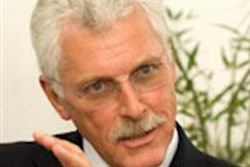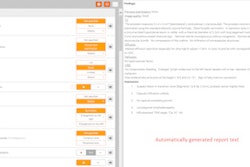
Although many radiologists in Italy are open to adopting structured reporting, technical and professional concerns have largely limited the technology's use in daily practice so far, Italian researchers reported recently in an article published online in European Radiology.
In a survey performed by the Italian Society of Medical Radiology (SIRM), more than three-quarters of responding SIRM members indicated that either no radiologists or less than half of radiologists were using structured reports at their institution. Although they generally perceived structured reporting to offer benefits such as improved report reproducibility, many participants also shared concerns about "overly rigid" reporting templates, the risk of excessively simplifying reports on complex cases, and even the potential loss of their professional reputation, according to a research team led by Dr. Lorenzo Faggioni of the University of Pisa.
"This de facto reluctance to leave conventional reporting for [structured reporting] adoption in radiological daily practice may be explained by the perceived disadvantages and current limitations of radiological [structured reporting]," the authors wrote.
Assessing adoption
Structured reporting has been shown in the literature to offer benefits such as improved workflow, reduced interreader variability, faster reporting times, and enhanced communication between radiologists and clinicians. However, questions have also been raised over the difficulty in accurately conveying all of the required information in a written template, as well as the need for randomized controlled trials to further demonstrate structured reporting's utility, according to the researchers (European Radiology, 29 August 2016).
As a result, the SIRM sought to survey its members in order to hear the opinions and assess the usage of structured reporting of its radiologist members. All SIRM members were invited to take an online survey consisting of 10 questions designed to gather demographic information, opinions on structured reporting, and adoption level of structured reporting.
Of the 9,560 members, 1,159 (12.1%) completed the survey. More than 50% of respondents worked in a public hospital, while over 28% worked in a private hospital or private center. The remainder worked at a university hospital, research institute, or an "other" location.
While 457 (40.3%) of 1,133 respondents accurately defined radiological structured reporting, 354 (31.2%) provided a less correct, but still plausible definition, according to the researchers. However, all others showed a lack of basic knowledge of radiological structured reporting, including 217 (19.1%) who demonstrated confusion between the concepts of templates and structured reporting.
The survey also found a low level of structured reporting utilization:
- No use of structured reporting: 643/1,142 (56.3%)
- Less than 50% of colleagues use structured reporting: 249/1,142 (21.8%)
- More than 50% of colleagues use structured reporting: 111/1,142 (9.7%)
Perceived advantages/disadvantages
The respondents highlighted report reproducibility among their perceptions regarding the potential advantages of structured reporting:
- Higher reproducibility of reporting with the possibility of adhering to validated classifications and guidelines: 799/1,143 (70.5%)
- Better interaction between radiologists and referring clinicians: 661/1,143 (58.3%)
- The option to add key images and other metadata to the report: 416/1,143 (36.7%)
In terms of perceived disadvantages, concerns over the use of structured reporting in complex cases were among the top three answers:
- Risk of excessively simplified reporting in complex cases: 676/1,130 (59.8%)
- Excessive rigidity of reporting templates: 634/1,130 (56.1%)
- Poor compliance by most radiologists used to convey information by means of conventional reporting: 476/1,130 (42.1%)
"Such concern [over the main perceived weakness of structured reporting] was also expressed quite extensively by participants in free text comments and came along with some radiologists' fear of losing their autonomy or even (as stated by some commenters) their professional reputation with respect to patients or nonradiologist specialists," the authors wrote. "This latter position might partially be explained by the fact that some radiologists with high subspecialty skills are worried about losing some of their professional authoritativeness once effective, validated [structured reporting] covering their area of interest would be made available to the radiological community."
When asked to rank their agreement or disagreement with a number of statements related to improvements for structured reporting, most respondents indicated agreement on the need for enhanced RIS/PACS integration:
- Agreed that radiological structured reporting improved RIS/PACS integration would play a significant role in making the use of more widespread and accepted by radiologists: 889/1,101 (80.7%)
- Strongly agreed that inclusion of free-text parts in radiological structured reports would be a welcome feature: 806/1,101 (72.3%)
- Strongly agreed that the inclusion of fields relating to imaging technique would be a welcome feature: 580/1,094 (53%)
- Agreed that radiological structured reports should be explicit even in case of unremarkable examinations: 824/1,088 (75.7%)
- Nonradiologist specialists should be allowed to have a role in the reporting process: 492/1,061 (46.4%)
"While [information related to the imaging protocol] has been recognized to be of paramount importance to aid protocol optimization and auditing procedures, spurring the development of DICOM-compliant monitoring tools with PACS integration, the requirements for successful practical implementation of radiological [structured reporting] indicated by the survey participants seem to reflect a perceived inadequacy of the currently available technical infrastructure that actually prevents a more widespread adoption of it," they wrote.
Broad support
Even though the radiologists often had concerns regarding structured reporting, there was still fairly broad support for the technology:
- Strongly supported radiological structured reporting: 342 (30%)
- Moderately supported radiological structured reporting: 651 (57.1%)
- Against radiological structured reporting: 84 (7.4%)
The researchers did not find any significant statistical association between support for structured reporting and radiologist age, geographic distribution, workplace type, and job position.
The team concluded that lingering concerns over structured reporting could be addressed with a broad-based effort.
"We believe that such hurdles to a more widespread adoption of radiological [structured reporting] can at least partly be overcome by the standardization and validation of templates with the endorsement of scientific societies, paralleled by a close collaboration between medical institutions and the industry for engineering and technical setup, as well as by continuous feedback from the radiological and clinical community for auditing of quality, communication efficiency, and overall user satisfaction," the authors wrote.



















